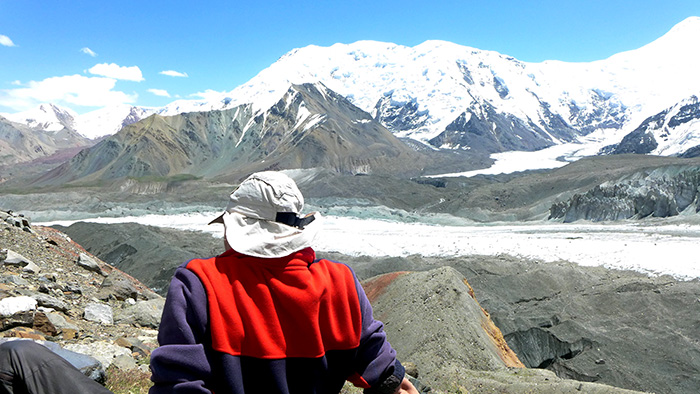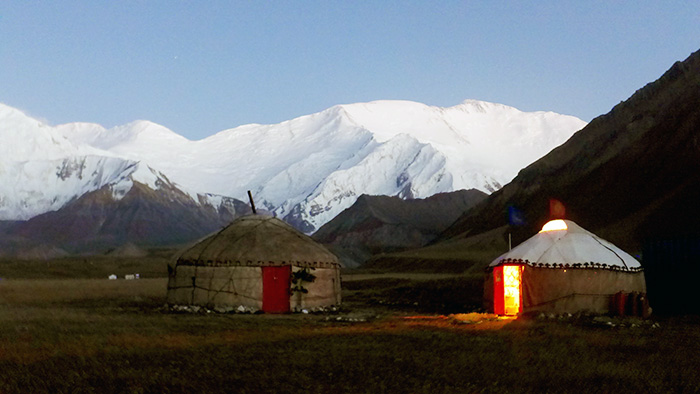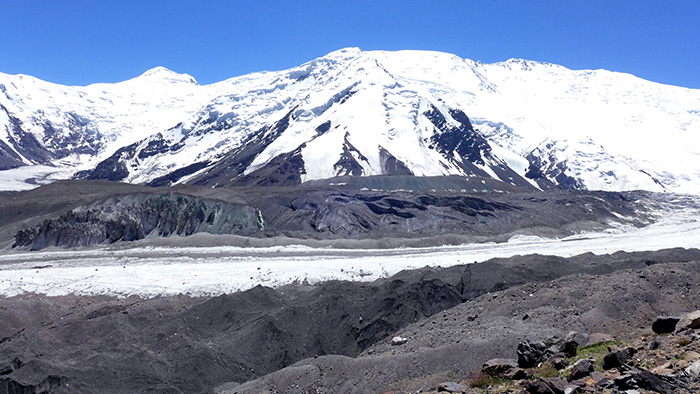Most people do not understand why on earth some of us would ever bother to climb mountains. They may have admitted to a passing fascination until they saw EVEREST. That was all theconfirmation required to deem all those who attempt such feats as completely nuts. But there are also those among us who remained undaunted, as determined as ever to continue to pursue higher mountains.

My daughter and climbing partner, Amira, age 19, shares my passion for the mountains along with those aspirations. Though we have many years of mountain experience trekking together, and a solid base of mountaineering skills through courses in Nepal and Switzerland, much of our experience has been what you would call ‘catered climbing’. Though trekking peaks are certainly challenging in their own right, mountaineering is just a whole new level. Trekking allows you to focus on getting yourself up the hill, while the porters carry the heavy boots and sleeping bags. But, to go higher, we were keen to learn independent skills of carrying, camping and cooking as well gain a substantial amount of altitude.
Lenin’s Peak is in Kyrgyzstan, a former Russian republic. The 7145m peak is in the Pamir Mountain range and is a key part of 5 other 7000 meter peaks in the same range, commonly referred to as the Snow Leopard. It is famous in Russia and becoming more popular among aspiring mountaineers due to its reputation of being, supposedly, “an easy 7000m peak’. I do believe that there are better reasons to justify calling a peak ‘easy’ other than the money and the time it takes to climb them. For one, the dangers of crevasses, both those covered by recent snowfall, which is constant, and those too big to be covered, should probably be a bit higher on the priority list. Insanely unpredictable weather and wind speeds that further drop the temperature into the negative 30’s especially at night. Some climbers on this mountain mistook the ‘easy’ description to justify their lack of safe climbing procedures such as being roped to at least 3 other climbers going over glaciers filled with crevasses. As a result there were lots of accidents. Perhaps another important fact would better explain: out of 150 climbers in the first 25 days of the season, only 2 actually reached the summit. Even Mt. Everest has better summit statistics! Judging from the conversations with those descending along the same route and our fellow climbers at the advanced base camp, it seemed that reaching Camp 2 was considered a really great achievement. Getting beyond that to Camp 3, worthy of a grand salute, and anyone who managed to even take a few steps outside of Camp 3 towards the realization of a successful summit, simply superhuman status.

Physically getting in shape for a mountain over 6000m required dedication. Though we trained hard; on average of an hour per day running, climbing stairs with ankle weights, running up the slopes in Ski Dubai, weekend back to back day hikes until the middle of June, we still underestimated how hard it would be to trek and be really comfortable with the heavy pack and all of gear that is suddenly on your body. Boots and crampons weigh at least 1kg on each foot, a harness with carabiners clanging, a constant reminder of their extra ounces, slings and your axe in one hand. Before you even put on the backpack, you are carrying at least an extra 5kg.
We addressed this gap in our training in the weeks just before departure. We headed to Nepal to do a training trek; carrying our 16kg packs for 6 days from 1500m up to 4800m and back down. Then, after 4 days of rest, we headed to Mt. Elbrus, at 5642m, in Russia with our UAE Trekker Team to pre-acclimatize. With only one day of rest between, we headed for Lenin with our international team of 8 from France, Saudi Arabia, Portugal, Germany, and USA. In hindsight, there is perhaps a finer line between intense preparation, and overexertion leading to exhaustion before your boots even hit the snow.
Of the 21 days on expedition, 17 were on the mountain, and 6 to 8 days of total self -sufficiency. Calculating food rations was a tricky business; though you need around 10,000 calories per day, you may not have energy left to cook, or no appetite to eat anything. Including more options for food means additional weight, and every little tuna can adds unwanted ounces. To top up our meals, we opted for Chinese energy bars that apparently are eaten on Everest (that marketing technique worked well on me) that could also double as tea, containing 5,000 calories in one bar.
When you arrive at Base Camp, your guide, who will hopefully speak English, will inform you abruptly, “6 pm. We discuss. ” Though we chalked this up to the tough talking slightly arrogant Kyrgyzstani attitude at first, but we soon realized it was actually our own arrogance/ignorance. The mountain weather determines your schedule, the guide only interprets how you will adapt to it.
Soon enough, we started to roll with the rhythm of the mountain. Wake up timings on the mountain are always early, but more often the sunrise wake-up call is due to the fact that you have your been in your tent since just after nightfall and will have likely have to answer for your attempts at staying well hydrated. So you extricate yourself from your sleeping bag and make a run around and over a hill in hopes that nobody beat you to the “five star” toilet. Otherwise known as the tin box with a hole in the bottom. Breakfast means eating your requisite fried egg, something with dill, and a sausage. Experience already taught us the folly of picky eating and meal skipping. In Russia, they say ‘no porridge, no summit!’ Because of the resulting fatigue and lack of energy from no food in your stomach. We eat whatever is on our plate on a mountain and are grateful for it.
After your breakfast, you will likely be ‘acclimatizing’ which means following the principle of climbing high and sleeping low. The trek is usually on slopes so steep that they require a zig zag from one side of a slippery rock to the other. The way back is usually down a deep scree path where you can literally ‘ski’ your way to the bottom in half the time it took to get up.

After 5 days of acclimatising, you will arrive at Advanced Base Camp, where the days are marked by how windy, how hot, or how cold or how snowy they are. The variations are incredible. One minute the sun is out and you urgently escape your layers. The next minute, as the sun goes behind the cloud, you search for them. You spend most time in the group dining tent and just outside it watching teams going up or coming down and listening to stories of those that have completed their first acclimatization ‘rotation’. They are always insane stories about crevasses, the unexpected difficulty, and the cold. Then, waiting for 6pm to discuss what will happen at 2am. The questions, though they have been answered already, are nearly the same each day. How long will it take to reach Camp 2? What if the snow covers the crevasses? What if I have to turn around? Our guide provided calm, unwavering answers. ‘Tonight we see at 2am. We see the weather. If weather good for climb, we go. If no, we sleep. We go up, we see the snow. We see your feeling. Not feeling good? We come back. Feeling good? Good weather? We go up.”
Yes, it really was that simple. But they were not simple answers to accept. “Not feeling good – go down”is not what you want to hear when you have planned, prepared, and trained for six months.
In the end, your body tells you in no uncertain terms what you will be allowed to do. That’s just the end of the story. That may sound like a wimpy cop-out for those that are used to hearing ‘push hard! You don’t know what your limits are until you pass them!”, but not when it comes to oxygen deprivation at high altitude where there are no water stations, sponge stops or ambulances at the finish line. You must listen to your body and let it define your limits. If one day you could breathe and the next, for some reason, finding the strength to get to the toilet box is a challenge, you know that this is a not a fight-on-through moment. The difficult part is accepting that your body and your mind have suddenly entered into an unwinnable conflict; head wants to go up, body wants to go down. Body always wins.
If you want to take your climbing to the next level, past ‘catered climbs’ and ‘trekking peaks’ towards expedition level peaks over 6000 meters, take a season to learn these independent skills. Buy all of your own gear to ensure good fit and comfort, and learn how to use it all with confidence. Train with weight, on your ankles and your back. Get uphill as much as you can, for extended periods. Learn the confidence you need in mountaineering skills in the Alps or on lower peaks in Nepal or India without dealing with the effects of altitude.

Though most of us climb just for ourselves and our own personal goals and ambition, one team member, Mona Shehab from Saudi Arabia, dedicated the attention she received for attempting this 7000m meter peak to funding Syrian children’s education in Lebanon. Though her exciting posts and eventful updates throughout the climb, she received 100,000 USD in donations for their education, which made her efforts completely worthwhile.
Throughout our previous trekking mountains and experiences, we have been lucky to have experienced mountaineering mentors who have taught us valuable lessons in our pursuit of our dreams. Lakpa Sherpa and Chris Jenson Burke together have climbed 10 of all 14 8,000 meter peaks in the world. Their attitude towards each expedition is ultimately one of gratitude of the chance to spend multiple weeks in the mountains, to experience everything it offers, (bad weather, storms, too much snow, too much sun), to accept the outcomes of the expedition and to listen to your body. A summit is a bonus, far from the only reason to climb. Though this philosophy may seem very relaxed for the challenges confronted on an expedition, it captures perfectly the zen that mountains inspire.
These are all important lessons to take to heart when you head to higher and tougher mountains where it is more likely not to reach the summit on the first attempt. In the end, every trekking and mountain experience adds to your overall knowledge, understanding and acceptance of the fact that whatever happens on the mountain will happen and you should learn to enjoy yourself, whether or not you get that summit.
Words + Photos by: Amy Subaey

